A Guide for Relating to Ritual Practice in Tibetan Buddhism
This introduction presents a few of the most commonly practiced rituals you may encounter at a Dharma center or temple in this tradition. The world of ritual is extremely complex and multi-faceted. We could write large volumes on the significance and history of many of the practices. But here we aim to answer some questions and help you open your minds to the possibilities of ritual and to give it some context. The practices presented here are all found in the Chokling Tersar tradition of the Nyingma school of Tibetan Buddhism. However, many of the rituals described are found in other schools and even in other traditions. For example, all Buddhist traditions offer lights and flowers to representations of the Buddha.
Mindfulness and Meditation: Not All of Buddhist Practice
Mindfulness and meditation practice with its physical and mental benefits are a popular topic these days. When we focus only on mindfulness and silent or sitting meditation sessions, however, we may be missing out on positive changes to our daily lives that can come about with other practices, commonly referred to as rituals. With ritual practice, we tame our minds as we carefully carry out particular physical and verbal actions.
This form of mind training is itself meditation practice, although it is rarely presented in those specific words. As we bring mindfulness to our physical, verbal, and mental actions, we can remain present throughout our activities. Ritual, rather than binding us to old-fashioned customs, is a way to express our values and truths joyfully and dynamically.
To integrate these ideas into our life, it is helpful to pay special attention to rituals that aid in turning our mind to the Dharma, also known as going for refuge. We set up a physical shrine and begin to incorporate ritual practices to support and encourage ourselves to practice. We place a Buddha image before us to remind us of the outstanding qualities of the Buddha and his teaching, the Dharma, and our wish to emulate him. Thus, when we go about our daily activities and also when we sit to contemplate and meditate, we do so with the clear motivation to realize awakening for the benefit of all sentient beings. This attitude encourages the giving up of our constricted thinking and the opening of our minds. We contemplate that we are deeply connected to all other sentient beings, as infinite as space.
Common Tibetan Buddhist Rituals
The following descriptions are brief introductions to some of the ritual activities that you might encounter in practice centers and are designed to answer questions for newcomers. There are many levels of meaning, but these short explanations will help you gain comfort with these activities and demystify some of the sights, sounds, and activities that go on in Tibetan and other schools of Buddhism. If you wish for a longer explanation, please see the discussion on ‘What is Ritual’. We also strongly encourage you to ask questions of resident and visiting lamas, resident and visiting instructors, and senior students.
Entering a Tibetan Buddhist Space
The Altar
At the entrance of the Center or practice space, you will see an altar on the opposite wall which will feature items representing the various auspicious qualities of the Buddhas and dharma. The altars can be arranged in a simple to complex styles reflecting the allegiances of the community. They will include representations of the Buddha Shakyamuni, deities, or other gurus and buddhas either as statues or paintings called thangkas. Flowers, incense, and lights add to the ornamentation. If the group is practicing a particular sādhana (see below) you may observe other ritual implements.
Removing Shoes
Entering the shrine room or teaching space, we leave our shoes at the door. In all cultures, many rituals center around defining spaces—public versus private—just like in your own home. In Asian countries shoes are generally not worn indoors for the simple reason that they bring in the dirt. Just as we wouldn’t bring dirty shoes into our own homes, we respect the purity of the shrine space.
Yes, this is cultural—but it also can serve an important function for those of us who don’t automatically remove footwear. When we take a few extra minutes to remove our shoes we have an opportunity to think, ”I’m entering a sacred space”. Especially if we’ve rushed to our dharma center or group after a busy day, this physical pause reminds us to reorient our busy minds. And you can always wear a pair of thick socks if you don’t want cold feet!
Feet are considered to be the lowest, dirtiest part of the body, particularly in Asian cultures. For this reason, Buddhists take care not to point their feet toward a Buddha image or the teacher. Please be sensitive to this tradition, and try to sit with your feet under your chair. And when we sit on the floor, we don’t stretch our legs out in front of us. Obviously, you will need to shift to get comfortable from time to time, so simply be mindful of where you point your feet.
Bowing
ll Buddhist cultures have incorporated some form of bowing as a sign of respect. The actual physical performance varies from country to country, but this practice goes back to the earliest recorded teachings of the Buddha. In the texts, we often read how a monk, nun, devout layperson, or curious seeker, approached the Buddha and paid respect by circling him three times (a process known as circumambulation). Next, the stories inform us that the person then bowed and sat down respectfully to one side.
Prostration
When Tibetan Buddhists enter a shrine room, or when we greet a teacher or stand before a Buddha image, we perform three deep bows, known as prostrations. The number three corresponds to the Triple Gems of Buddha, Dharma, and Sangha. In Tibetan, the term for prostration is chak tsal (Wyl. phyag ‘tshal). The first part, “chak” has the meaning of sweeping or brushing away—as one would sweep dirt. Through prostrations, we are sweeping away the negative actions we have accumulated in the past. The second part of the term, “tsal” means to receive blessings. So, we first purify ourselves of misdeeds and our ignorance of the nature of things, and then we gather the qualities that allow us to awaken to full understanding.
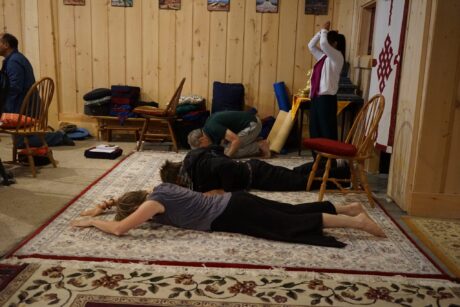
There are several variations of prostration, but generally speaking, we first hold our palms together in the shape of a lotus and touch the top of the head, throat, and heart. These three places represent our body, speech, and mind. We then bow forward and touch the crown of our head, the palms, and the knees to the floor. These “five points” of the body represent the five poisons (greed, anger, jealousy, pride, ignorance) that we are purifying. Prostrating, or bowing in this way is a tangible reminder to overcome our pride. When we touch the highest part of our body, the head, to the ground, we are using our physical bodies to destroy our habitual ego-clinging.
Please take your time, and don’t feel pressured to prostrate if you don’t wish to do so. A prostration should be offered joyfully, with the benefit of all beings in mind.
Where and How to Sit
Traditionally, Asian Buddhist practitioners sit on the floor in a variety of positions depending upon their flexibility. However, if we are not used to floor sitting, this may not be the most comfortable position for us. If we want to sit on the floor, we can adopt one of several classic variations of the cross-legged, or lotus position. It may help to sit on a meditation cushion, and your meditation instructor can work with you to help find the most comfortable posture.
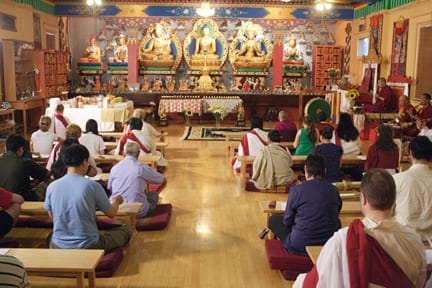
Please feel free to use a chair for your meditation. If you do choose to sit in a chair, sit forward a bit, away from the back so that you don’t slump. The most important instruction is to keep your spine as straight as possible, but do this in a relaxed way—we’re not adopting a ramrod-straight military bearing. If you keep your legs parallel and place your feet flat on the floor or a low bench it will be helpful.
How to Hold Your Hands
You may place your hands on your lap in the meditation posture—right hand on top of the left with both palms facing up, and the thumbs lightly touching. Alternatively, you may wish to gently rest your palms face down on your upper thighs. You may wish to experiment with both these positions to determine which is more comfortable—and you may wish to alternate occasionally.
Offerings
As Buddhists, we often offer lights or flowers, as is common in many other religious traditions. Additionally, we often arrange a series of bowls filled with pure water. And on special occasions, we make abundant offerings of food and drink. Obviously, the statues or paintings don’t benefit from these physical gifts. So what’s the point?
In 2015, Phakchok Rinpoche discussed the importance of making offerings:
Many people I have met while traveling in the west are confused about why we put out “offerings” like flowers, clean water, and candles.
So let me try to explain… take something as simple as a flower. When you offer the flower, hold it in your hand and think to yourself, “This flower is my realization, my potential, my accumulation of merit, all my wealth, my name, my reputation, my attachments, all the things that I would like to have in the world, all the beautiful and luxurious things, all the pleasant experiences”…basically everything that you are attached to, you offer it up, freely, without holding back.
The same thing applies when you offer water. “May the gesture of offering this water clean and purify all sentient beings negativities. By offering this water may I always remind myself of the cleansing power of compassion.”
When you offer a candle think, “May the light of this candle illuminate the darkness of ignorance and negative emotions. May the light of this candle shed light on the preciousness of my life and the truth of impermanence.”
When you practice like this, the flower, the water, and the candle are no longer just an ordinary object. They actually transform your motivation and become an action of generosity. This will definitely reflect back into your life in a positive way. But don’t trust me, try it yourself and see.
Rituals at Tibetan Buddhist Dharma Centers: Chanting and Mantras
Chanting
When Buddhist practitioners gather to practice, we begin both teaching or meditation sessions by chanting. This in itself is a practice in mindfulness and in setting our intention. Buddhist teachers always stress the importance of beginning every activity with proper motivation. Thus, before and after we study or meditate, we spend some time chanting verses that remind us of what we wish to accomplish.

In the Tibetan tradition, we speak of the three excellences of practice. These are the excellent beginning, the excellent main part, and the excellent conclusion. We prepare for our main practice of either listening or meditating on teaching by chanting. And after the main part finishes, we conclude by chanting again. The chants vary by occasion, but in general, we start by reminding ourselves of what we are about to do. We check our motivation and make sure that our minds are calm and clear of any negative thinking. And we invoke the good wishes and blessings of previous masters in our tradition. To conclude, we rejoice in our good fortune and ability to practice, and we dedicate any benefits of our practice to all sentient beings.
Language and Music
In some situations, we chant in the original Tibetan language (courtesy of helpful phonetics). Alternatively, we may chant in English or our own native language. And sometimes, we may do both. When we chant in Tibetan, we use specific tunes that have been passed down over centuries. The lamas teach that these tunes themselves are very beneficial for calming our minds. In very traditional settings, we may play some musical instruments such as drums, horns, and cymbals. Read more about Tibetan Buddhist musical instruments here. Again, these accompaniments are carefully orchestrated to mark special places in a text and to arouse particular beneficial emotional states.
Western science has begun taking a closer look at chanting out loud, particularly in group settings. Melodious chanting seems to have a therapeutic effect on our nervous systems and our immune systems. Studies have shown that blood pressure lowers and heart rates slow during chanting. A recent study also showed how religious chanting reduced fear and anxiety in participants who were shown images designed to provoke fear and anxiety. And although we can chant alone, we get more benefit from group participation.
Mantra
A mantra is a phrase, usually in Sanskrit, that is repeated continuously for a period of time to cultivate or enhance a particularly beneficial and wholesome state of mind. The repetitions can be done in a group or alone. Sometimes we refer to Vajrayana Buddhism as the “vehicle of mantra”. Mantras existed in India before the time of the Buddha, and the Vedic scriptures speak of the sacred nature of sound. Yogis believed that certain sounds produced particular resonance in the body, helping regulate the mind and the body. Recitations are more beneficial than merely listening—when we recite, we are more focused on syllables and sounds, and our mind wanders less.
In Tibetan Buddhist practice, there are countless mantras, and they are usually associated with particular deities. We chant the mantras of these deities to establish a close connection with the qualities of that enlightened activity. You may also hear mantras recited during aspiration and dedication chants.
However don’t stress about knowing the literal meaning—mantra is known as “vajra speech” because the sound itself has some power. Likewise, when you are learning to chant mantras, it takes some time to develop fluency with the strange sounds.
Malas and Mantras
During the chanting periods of your visit, you may notice that the practitioners are using prayer beads known as malas. Generally speaking, we use malas, or prayer beads, to count these prayers. Malas have 108 beads, and we often recite a full mala of a particular mantra. You may still say the mantras even if you do not use the malas. You may notice many different colors or types of malas. A practitioner often buys a particular type of mala depending on the type of practice he or she is doing, so it is always good to check with a lama or instructor or senior student before purchasing a mala.
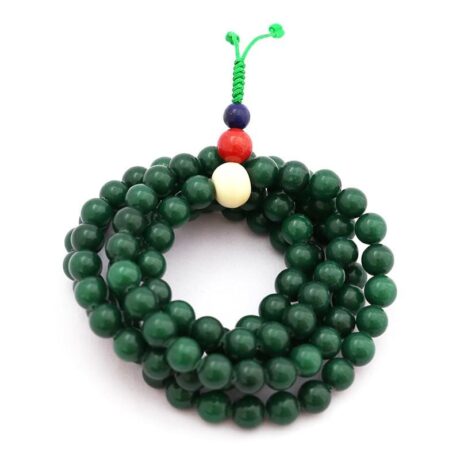
Our sister organization, Akara Collection offers a variety of quality malas.
Khataks or White Scarf Offerings
Khatak (most traditionally a white scarf) is often offered to a teacher upon meeting him or at the end of a program when it is also appropriate to donate for the teaching. Often we approach the teacher with the hands in prayer mudra. The khatak should be folded in half (longways) and then extended forward for the teacher to accept, as in the photo here. If you offer a khatak to a qualified teacher or lama, they put the scarf back over your head as a blessing. Traditionally khataks were made of white silk, but these days they are often polyester. You may find them in solid colors of blue, red, yellow, and green or with screened prints as well.
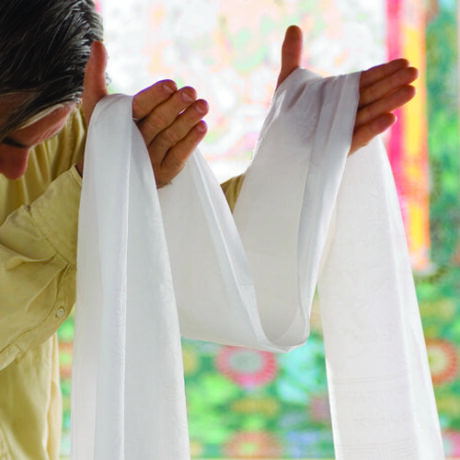
In this video from 2015 in Brasil, you can see students offering khatak to Phakchok Rinpoche on his arrival at their dharma center.
When offering a khatak to anyone else (monks and nuns who are not teachers, laypeople, etc.), traditionally they keep the khatak. The protocol for offering khataks varies in practice centers. Don’t hesitate to ask what is the protocol if you are unsure. Centers that encourage this offering usually have khataks available for purchase. They may also offer envelops for the donation. Since it is an offering, it is best that you buy it rather than borrow one. If you forget to bring one, it is better to borrow one than not to offer at all.
Group Practice
Throughout history, meditators practiced together in both small and larger communities of forest or mountain dwellers. We sometimes have this romantic notion of the solitary yogi and think that we can do it all on our own. It is important to remember that the famous yogis who meditate alone in caves usually had years of experience!
Group practice is important because you feel supported. Meditation can actually be boring or frustrating in the beginning. Thus it helps to join together with people who are also training. By simply showing up for a group practice session, you are more likely to sit for a longer period. And many people report they sit with more focus. The third jewel of the three jewels is sangha—or community. When we practice among like-minded individuals, we feel supported and more confident in our practice.
Group Sadhana
In Tibetan centers, most group practice consists of a ritual discourse known as a sadhana (literally a “means of accomplishment”). There may or may not be a prolonged period of silent sitting as found usually in Zen Buddhist or Theravada centers. Usually, the organizers provide a text of the discourse. The group may chant in Tibetan or the common language of the community. If the recitation is going too fast for you, you may simply sit and read the discourse. The sadhanas contain valuable teachings in their poetry.
Prayer Flags
Tibetan Buddhists display colorful prayer flags at centers, around their homes, and in natural sites such as mountain passes, streams, and sacred sites.
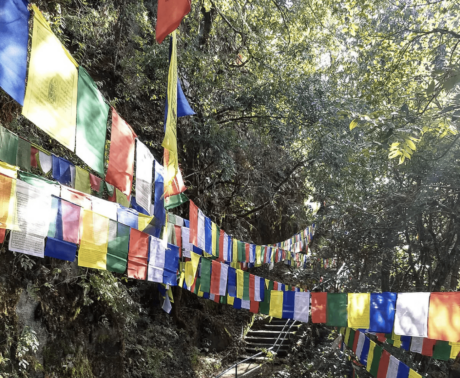
Sacred texts adorn the five-colored squares of cloth. Various astrological texts claim that the five colors (blue, white, red, green, and yellow) symbolize the five elements. Most often they are arranged following the generic enumeration of the five elements, namely earth, water, fire, wind, and space. Blue symbolizes space, white symbolizes clouds, red symbolizes fire, green symbolizes water, and yellow symbolizes earth. Prayer flags are thus an auspicious omen for the continued propagation of all harmonious factors, such as longevity, merit, power, fortune, fame, and reputation.
Tibetan Buddhist Ritual Practice and Auspicious Days
You will hear people talk about special dates as particularly important for practice and the performance of rituals. These can be likened to cultural holidays or events like Valentine’s Day. Texts explain that the results of positive actions multiply naturally on these days. But we also should keep in mind that the effects of our negative actions also increase.
The sadhanas you may first encounter will have been chosen based on the qualities of these dates. Because the qualities are vast and the sadhanas numerous, each center may select something unique.
Sang
During some sadhanas and on certain days, you may encounter a sang puja which is a profound Vajrayana offering practice. The word sang in Tibetan has a broad range of meaning—remove, take away; purified, cleared, cleansed, and awakened. As such, we consider sang puja a purification practice. We focus on removing the impurities in the mindstream of the practitioners.
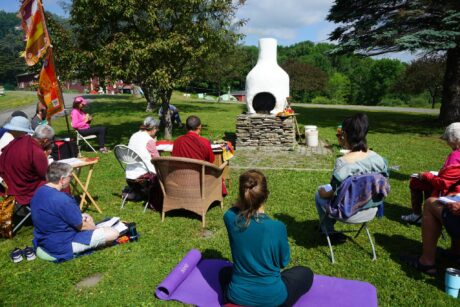
At the same time, we make offerings to four classes of invited ‘guests’. During the physical ritual, we burn different woods, incense, and many other substances such as ground gemstones and brocades. Fragrant smoke arises and becomes an offering to all the many beings seen and unseen.
Sang incorporates the practice of generosity in the vastest way we might imagine. Thus, as we engage in this practice, we are expanding our ordinary point of view beyond our normal capacity.
Sur
Sur is an ancient offering practice where we mix flour, sweets and dairy products, and precious and aromatic substances. The specific substances may differ depending upon the type of practice we are doing. In the ceremony, which can be either short or very elaborate, we first consecrate these substances. Then we place them in a fire where it becomes an aromatic offering. As with other offerings, we visualize the objects of refuge and first offer this fragrant cloud to them. Then, we extend the offering to all sentient beings. This offering particularly benefits those recently deceased.
Conclusion
Dharma practice is wholly experiential. Meditation is the key requirement for the cultivation of wisdom and compassion leading to full realization. But we can support our meditation best by several enhancing practices. Thus, we include discipline, ethics, mind training, and particularly ritual activities. Hopefully, this article has introduced some of the activities you will encounter when first visiting a Tibetan Center so your experience will be comfortable and inspiring.
We encourage you to browse other articles on the Samye website to learn about specific practices. Also, do not hesitate to post questions to our General Student Forum. There a qualified Samye instructor will be happy to answer your queries.


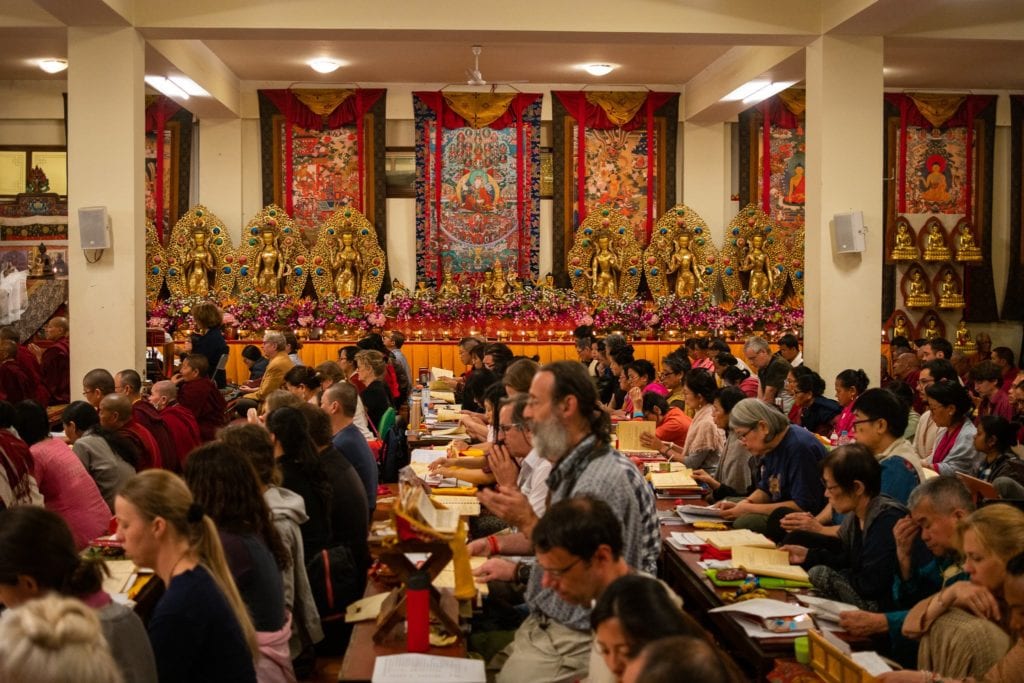







Responses
… [Trackback]
[…] There you will find 12637 more Info on that Topic: samyeinstitute.org/sciences/philosophy/rituals-at-tibetan-buddhist-dharma-centers/ […]
… [Trackback]
[…] Find More Info here on that Topic: samyeinstitute.org/sciences/philosophy/rituals-at-tibetan-buddhist-dharma-centers/ […]
… [Trackback]
[…] Here you can find 49201 additional Info to that Topic: samyeinstitute.org/sciences/philosophy/rituals-at-tibetan-buddhist-dharma-centers/ […]
… [Trackback]
[…] Read More on on that Topic: samyeinstitute.org/sciences/philosophy/rituals-at-tibetan-buddhist-dharma-centers/ […]
… [Trackback]
[…] Read More here on that Topic: samyeinstitute.org/sciences/philosophy/rituals-at-tibetan-buddhist-dharma-centers/ […]
… [Trackback]
[…] Here you will find 1916 more Information to that Topic: samyeinstitute.org/sciences/philosophy/rituals-at-tibetan-buddhist-dharma-centers/ […]
… [Trackback]
[…] Find More here on that Topic: samyeinstitute.org/sciences/philosophy/rituals-at-tibetan-buddhist-dharma-centers/ […]
… [Trackback]
[…] Find More on to that Topic: samyeinstitute.org/sciences/philosophy/rituals-at-tibetan-buddhist-dharma-centers/ […]
… [Trackback]
[…] Read More Information here to that Topic: samyeinstitute.org/sciences/philosophy/rituals-at-tibetan-buddhist-dharma-centers/ […]
… [Trackback]
[…] Here you can find 41915 additional Info to that Topic: samyeinstitute.org/sciences/philosophy/rituals-at-tibetan-buddhist-dharma-centers/ […]
… [Trackback]
[…] There you can find 96148 more Information to that Topic: samyeinstitute.org/sciences/philosophy/rituals-at-tibetan-buddhist-dharma-centers/ […]
… [Trackback]
[…] Here you will find 41462 additional Information on that Topic: samyeinstitute.org/sciences/philosophy/rituals-at-tibetan-buddhist-dharma-centers/ […]
… [Trackback]
[…] Find More here on that Topic: samyeinstitute.org/sciences/philosophy/rituals-at-tibetan-buddhist-dharma-centers/ […]
… [Trackback]
[…] Find More on on that Topic: samyeinstitute.org/sciences/philosophy/rituals-at-tibetan-buddhist-dharma-centers/ […]
… [Trackback]
[…] Info on that Topic: samyeinstitute.org/sciences/philosophy/rituals-at-tibetan-buddhist-dharma-centers/ […]
… [Trackback]
[…] Find More to that Topic: samyeinstitute.org/sciences/philosophy/rituals-at-tibetan-buddhist-dharma-centers/ […]
… [Trackback]
[…] Here you will find 93769 more Info on that Topic: samyeinstitute.org/sciences/philosophy/rituals-at-tibetan-buddhist-dharma-centers/ […]
… [Trackback]
[…] There you can find 29920 more Information on that Topic: samyeinstitute.org/sciences/philosophy/rituals-at-tibetan-buddhist-dharma-centers/ […]
… [Trackback]
[…] Read More on to that Topic: samyeinstitute.org/sciences/philosophy/rituals-at-tibetan-buddhist-dharma-centers/ […]
… [Trackback]
[…] Find More to that Topic: samyeinstitute.org/sciences/philosophy/rituals-at-tibetan-buddhist-dharma-centers/ […]
… [Trackback]
[…] Find More Information here on that Topic: samyeinstitute.org/sciences/philosophy/rituals-at-tibetan-buddhist-dharma-centers/ […]
… [Trackback]
[…] Information to that Topic: samyeinstitute.org/sciences/philosophy/rituals-at-tibetan-buddhist-dharma-centers/ […]
… [Trackback]
[…] Read More on to that Topic: samyeinstitute.org/sciences/philosophy/rituals-at-tibetan-buddhist-dharma-centers/ […]